CCRN
Latest uploads at CCRN. Looking for notes at CCRN? We have lots of notes, study guides and study notes available for your school.
-
1400
- 0
-
76
All courses for CCRN
-
CCRN 1394
-
CCRN , 1
-
CCRN 1
-
CCRN! 2
Latest notes & summaries CCRN
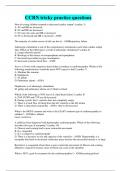
How do young children respond to decreased cardiac output? (cardiac 3) A. SV and HR are increased B. SV and HR are decreased C. SV stays the same and HR is increased D. SV is decreased and HR is increased - ANSC The majority of cardiac arrests in kids are due to - ANSRespiratory failure Adrenergic stimulation is one of the compensatory mechanisms used when cardiac output fails. Which of the following is a result of adrenergic stimulation? (cardiac 6) A. Longer diastolic period B. Blocka...
- Exam (elaborations)
- • 33 pages's •
-
CCRN•CCRN
Preview 4 out of 33 pages
How do young children respond to decreased cardiac output? (cardiac 3) A. SV and HR are increased B. SV and HR are decreased C. SV stays the same and HR is increased D. SV is decreased and HR is increased - ANSC The majority of cardiac arrests in kids are due to - ANSRespiratory failure Adrenergic stimulation is one of the compensatory mechanisms used when cardiac output fails. Which of the following is a result of adrenergic stimulation? (cardiac 6) A. Longer diastolic period B. Blocka...
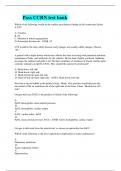
Which of the following would be the earliest auscultatory finding in left ventricular failure (LVF)? A. Crackles B. S3 C. Murmur of mitral regurgitation D. Pericardial friction rub - ANSB. S3 LVF would be the most subtle because early changes are usually subtle changes. Choose "S3." A patient with a triple-lumen subclavian catheter has been receiving total parenteral nutrition, maintenance fluids, and antibiotics by the catheter. He has been slightly confused. Suddenly he grasps the ...
- Exam (elaborations)
- • 42 pages's •
-
CCRN•CCRN
Preview 4 out of 42 pages
Which of the following would be the earliest auscultatory finding in left ventricular failure (LVF)? A. Crackles B. S3 C. Murmur of mitral regurgitation D. Pericardial friction rub - ANSB. S3 LVF would be the most subtle because early changes are usually subtle changes. Choose "S3." A patient with a triple-lumen subclavian catheter has been receiving total parenteral nutrition, maintenance fluids, and antibiotics by the catheter. He has been slightly confused. Suddenly he grasps the ...
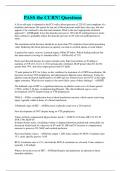
A 56 yr-old male is admitted to the ICU with a blood pressure of 225/135 and complains of a headache and nausea. He reports he ran out of blood pressure meds three days ago, but also appears to be confused to the date and situation. What is the most appropriate treatment approach? - ANSRapidly lower the diastolic pressure to 100 with IV antihypertensive meds, then continue to gradually reduce the diastolic pressure to 85 with oral antihypertensive meds. The maximum initial decrease should ...
- Exam (elaborations)
- • 14 pages's •
-
CCRN•CCRN
Preview 2 out of 14 pages
A 56 yr-old male is admitted to the ICU with a blood pressure of 225/135 and complains of a headache and nausea. He reports he ran out of blood pressure meds three days ago, but also appears to be confused to the date and situation. What is the most appropriate treatment approach? - ANSRapidly lower the diastolic pressure to 100 with IV antihypertensive meds, then continue to gradually reduce the diastolic pressure to 85 with oral antihypertensive meds. The maximum initial decrease should ...
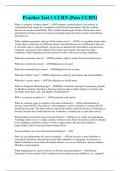
What is vasogenic cerebral edema? - ANSVasogenic cerebral edema is an increase in extracellular fluid caused by a breakdown of the blood-brain barrier with the resultant increase in vascular permeability. This cerebral edema begins locally and becomes more generalized. Common causes are trauma (including surgical trauma), tumors, hemorrhage, and abscesses What ventilator parameter indicates fluid volume excess? - ANSAn A:a gradient greater than 10 mm Hg is a reflection of a diffusion defec...
- Exam (elaborations)
- • 11 pages's •
-
CCRN•CCRN
Preview 2 out of 11 pages
What is vasogenic cerebral edema? - ANSVasogenic cerebral edema is an increase in extracellular fluid caused by a breakdown of the blood-brain barrier with the resultant increase in vascular permeability. This cerebral edema begins locally and becomes more generalized. Common causes are trauma (including surgical trauma), tumors, hemorrhage, and abscesses What ventilator parameter indicates fluid volume excess? - ANSAn A:a gradient greater than 10 mm Hg is a reflection of a diffusion defec...
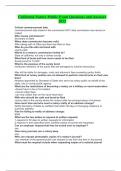
A 56 yr-old male is admitted to the ICU with a blood pressure of 225/135 and complains of a headache and nausea. He reports he ran out of blood pressure meds three days ago, but also appears to be confused to the date and situation. What is the most appropriate treatment approach? Rapidly lower the diastolic pressure to 100 with IV antihypertensive meds, then continue to gradually reduce the diastolic pressure to 85 with oral antihypertensive meds. The maximum initial decrease should be no m...
- Exam (elaborations)
- • 7 pages's •
-
CCRN•CCRN
Preview 2 out of 7 pages
A 56 yr-old male is admitted to the ICU with a blood pressure of 225/135 and complains of a headache and nausea. He reports he ran out of blood pressure meds three days ago, but also appears to be confused to the date and situation. What is the most appropriate treatment approach? Rapidly lower the diastolic pressure to 100 with IV antihypertensive meds, then continue to gradually reduce the diastolic pressure to 85 with oral antihypertensive meds. The maximum initial decrease should be no m...
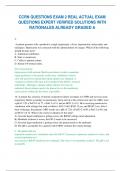
CCRN QUESTIONS EXAM 2 REAL ACTUAL EXAM QUESTIONS EXPERT VERIFIED SOLUTIONS WITH RATIONALES ALREADY GRADED A
- Exam (elaborations)
- • 20 pages's •
-
CCRN•CCRN
Preview 3 out of 20 pages
CCRN QUESTIONS EXAM 2 REAL ACTUAL EXAM QUESTIONS EXPERT VERIFIED SOLUTIONS WITH RATIONALES ALREADY GRADED A

CCRN Exam Questions with Correct Answers A 56 yr-old male is admitted to the ICU with a blood pressure of 225/135 and complains of a headache and nausea. He reports he ran out of blood pressure meds three days ago, but also appears to be confused to the date and situation. What is the most appropriate treatment approach? -Correct Answer= Rapidly lower the diastolic pressure to 100 with IV antihypertensive meds, then continue to gradually reduce the diastolic pressure to 85 with oral antih...
- Exam (elaborations)
- • 17 pages's •
-
CCRN•CCRN
Preview 3 out of 17 pages
CCRN Exam Questions with Correct Answers A 56 yr-old male is admitted to the ICU with a blood pressure of 225/135 and complains of a headache and nausea. He reports he ran out of blood pressure meds three days ago, but also appears to be confused to the date and situation. What is the most appropriate treatment approach? -Correct Answer= Rapidly lower the diastolic pressure to 100 with IV antihypertensive meds, then continue to gradually reduce the diastolic pressure to 85 with oral antih...
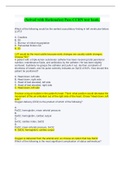
(Solved with Rationales) Pass CCRN test bank. Which of the following would be the earliest auscultatory finding in left ventricular failure (LVF)? A. Crackles B. S3 C. Murmur of mitral regurgitation D. Pericardial friction rub B. S3 LVF would be the most subtle because early changes are usually subtle changes. Choose "S3." A patient with a triple-lumen subclavian catheter has been receiving total parenteral nutrition, maintenance fluids, and antibiotics by the catheter. He has ...
- Exam (elaborations)
- • 47 pages's •
-
CCRN•CCRN
Preview 4 out of 47 pages
(Solved with Rationales) Pass CCRN test bank. Which of the following would be the earliest auscultatory finding in left ventricular failure (LVF)? A. Crackles B. S3 C. Murmur of mitral regurgitation D. Pericardial friction rub B. S3 LVF would be the most subtle because early changes are usually subtle changes. Choose "S3." A patient with a triple-lumen subclavian catheter has been receiving total parenteral nutrition, maintenance fluids, and antibiotics by the catheter. He has ...
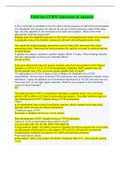
PASS the CCRN! Questions & Answers A 56 yr-old male is admitted to the ICU with a blood pressure of 225/135 and complains of a headache and nausea. He reports he ran out of blood pressure meds three days ago, but also appears to be confused to the date and situation. What is the most appropriate treatment approach? Rapidly lower the diastolic pressure to 100 with IV antihypertensive meds, then continue to gradually reduce the diastolic pressure to 85 with oral antihypertensive meds. The...
- Exam (elaborations)
- • 11 pages's •
-
CCRN•CCRN
Preview 2 out of 11 pages
PASS the CCRN! Questions & Answers A 56 yr-old male is admitted to the ICU with a blood pressure of 225/135 and complains of a headache and nausea. He reports he ran out of blood pressure meds three days ago, but also appears to be confused to the date and situation. What is the most appropriate treatment approach? Rapidly lower the diastolic pressure to 100 with IV antihypertensive meds, then continue to gradually reduce the diastolic pressure to 85 with oral antihypertensive meds. The...
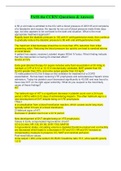
PASS the CCRN! Questions & Answers A 56 yr-old male is admitted to the ICU with a blood pressure of 225/135 and complains of a headache and nausea. He reports he ran out of blood pressure meds three days ago, but also appears to be confused to the date and situation. What is the most appropriate treatment approach? Rapidly lower the diastolic pressure to 100 with IV antihypertensive meds, then continue to gradually reduce the diastolic pressure to 85 with oral antihypertensive meds. The...
- Exam (elaborations)
- • 11 pages's •
-
CCRN•CCRN
Preview 2 out of 11 pages
PASS the CCRN! Questions & Answers A 56 yr-old male is admitted to the ICU with a blood pressure of 225/135 and complains of a headache and nausea. He reports he ran out of blood pressure meds three days ago, but also appears to be confused to the date and situation. What is the most appropriate treatment approach? Rapidly lower the diastolic pressure to 100 with IV antihypertensive meds, then continue to gradually reduce the diastolic pressure to 85 with oral antihypertensive meds. The...
